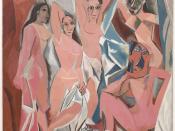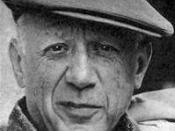"The Shock of the New Anything Goes"
Pablo Picasso and Damien Hirst are two notable artists who are exemplars of artists who display a significant departure from the use of traditional materials in creating artworks. They both challenged the concepts of artistic acceptance in existence at their time.
Born in 1881, Pablo Ruiz Picasso is one of the most well known artists in the world. He is a Spanish painter, ceramicist, and stage designer, and the creator of Cubism. At the beginning of the twentieth century he started the Blue Period which was a period of sadness in Picasso's life, influenced by the death of his friend. This period was followed by the Rose Period from 1905 to 1906 which was inspired by the circus and Paris. Picasso is most well-known for his cubist works and legendary symbolic works- such as Guernica. His cubist works were done between 1907 and 1920.
In this time, Picasso introduced methods of art making that were never used before, such as the use of collage.
Damien Hirst, born in 1965 is an English artist who primarily created art in the 1990s. His works mainly come under three areas: paintings, cabinet sculptures and forms in glass tanks. His paintings are mainly random spots with titles that refer to pharmaceutical chemicals, or "spin paintings" which are painted on a spinning table. The cabinet series are a display of collections of surgical tools or pill bottles on shelves. Hirst is best known for his Natural History series in which dead animals; such as cows, sheep or sharks are preserved and may be cut up, in formaldehyde. "Hirst's work is an examination of the processes of life and death: the ironies, falsehoods and desires that we mobilise to negotiate our own alienation and mortality." - Excerpt...


